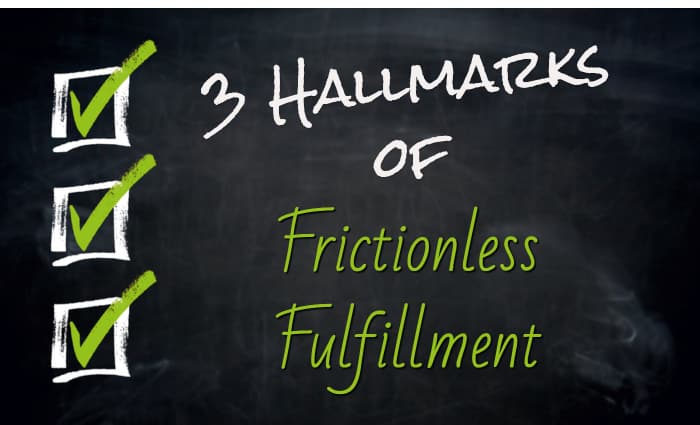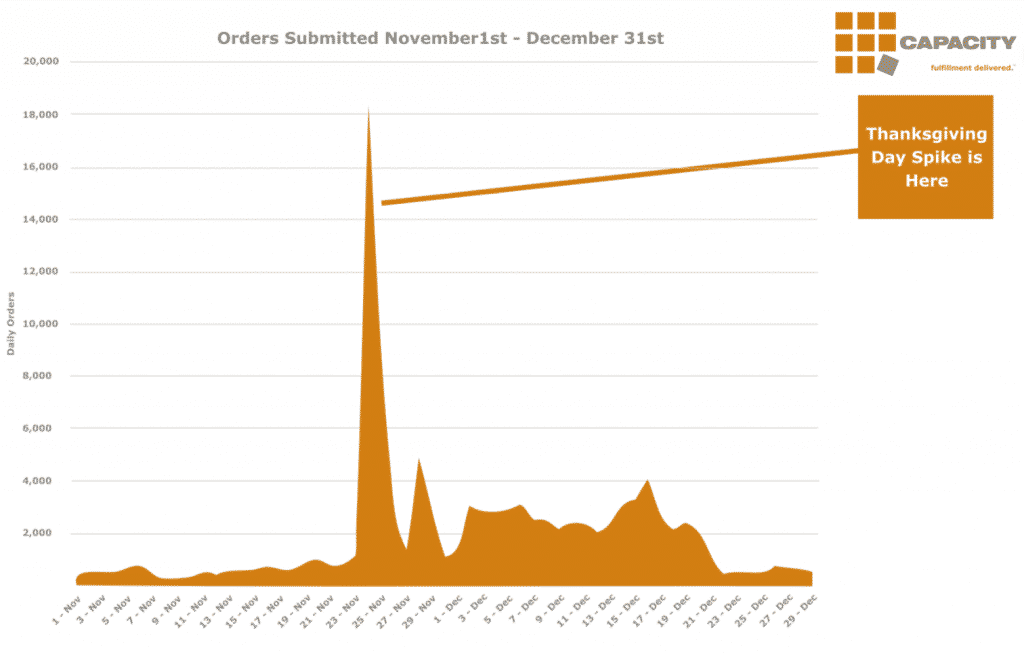3 Hallmarks of Frictionless Fulfillment
Now that we have so many ways to order and engage with brands, the importance of providing a frictionless experience for customers cannot be overstated. In addition to websites, storefronts, mobile apps, and the many other ways that buyers can engage with retailers, that consideration must also extend to frictionless fulfillment.
Research from Brightpearl and Endless Gain last year found that over 60% of respondents said they wouldn't want to buy from the same retailer again if they experienced a significant problem after purchase. This includes aspects related to fulfillment, such as inadequate packaging safety, delivery issues, or difficulties returning a problem.

What is Frictionless Order Fulfillment?
In order to achieve the wider goal of an efficient and smooth customer journey, frictionless fulfillment must enter the conversation. Everything from the initial availability of a product (on a shelf or in the warehouse) to estimated shipping time, order tracking, and delivery to the end customer, involves the retailer's order fulfillment solution in some way.
A frictionless order fulfillment process is one that presents all the required information when and where it's needed, allows customers to move across sales channels at their convenience, and delivers their order in a timely manner.
(We'd go so far as to say that the delivery and unboxing experience should also delight your customer, but that's less to do with friction and more to do with a dedicated fulfillment partner!)
Where customers experience a bump in the road of their customer journey, be it something as small as a missed order tracking update or as serious as a damaged delivery, a point of friction exists.
That gives them a reason to seek out competitors and share their negative experience with others. This has always been the case but it is amplified significantly in the eCommerce era, where fans will rave about the brands that serve them well and publicly rant about those who fail them.
A frictionless order fulfillment process makes it more likely that your business occupies the former category.
With the importance of a seamless order and delivery experience established, let's examine three characteristics that define a brand with frictionless fulfillment.

3 Hallmarks of Frictionless Fulfillment
From being able to order online then pick up in-person to adapting operational capabilities based on customer feedback, here are a few key hallmarks of frictionless fulfillment.
1) Seamless shift between channels (online and offline)
The phrase omnichannel fulfillment has been floating around our industry for many years, but the trials of big box retailers more recently have placed a sense of urgency on the need to align online and offline sales channels. Where once eCommerce strategy was separated from physical retail, both must now blend seamlessly to meet the expectations of modern consumers.
At the same time, the rise of direct-to-consumer (DTC) brands has convinced even the most traditional business sectors that eCommerce provides their most realistic opportunity for sustained growth.
In the consumer packaged goods sector during 2017, for example, online sales were responsible for 90% of CPG growth, despite making up just a fraction of the market. That trend has only accelerated as the decade draws to a close, leaving established and experienced brands playing catch up with startup competitors who have the advantage of being digital natives.
The path for brands in many different sectors of retail is becoming clear: find a way to leverage their real-world assets - robust supply chains, bricks-and-mortar stores, etc. - to better serve buyers who start their customer journey online.
Virtual stores, mobile apps, rapid shipping with multiple options for pickup or delivery, and an easy to understand returns process are all aspects of the purchase experience that need to be synchronized for a retailer to deliver frictionless fulfillment.

2) Two-way communication with fans of the brand
A common thread that runs between the most popular direct-to-consumer (DTC) brands on influential social media like Instagram and YouTube is engagement. Not in the tired vanity metric sense of the term, such as followers and likes, but rather the ability to engage in genuine two-way discourse with fans.
How does this relate to order fulfillment?
Because customers will offer feedback on everything from the way their order arrived to the kind of products they'd like to see in future. The most engaged will tell you not only why they love the brand but also what could be done better.
This extends to all aspects of fulfillment, from the acknowledgement that an order has been placed to its status through the shipping process and their experience with delivery, unboxing, and even how any returns are handled.
This is the kind of feedback that some companies pay handsomely to gather, whether through their own post-purchase communications or by employing third-party organizations to conduct surveys.
With that in mind, brands that embrace the ability to actively listen to fans on social media platforms, then engage in two-way communication to learn where they can improve, demonstrate that they understand the inherent value of this activity.
Acting on the information received and adapting the order process to deliver a better customer journey is a cornerstone of frictionless fulfillment.
3) Flexibility to scale quickly and cost-effectively
Even the most finely-tuned fulfillment process can fail when circumstances push operational capabilities past breaking point. A sharp spike in orders following an especially popular promotion or an early peak season rush holds the potential
The true measure of a frictionless fulfillment solution is not how it performs in normal operating conditions, but more how it handles the need to scale up and down quickly, sometimes with very little warning.

In practice, this means designing a system, whether internal or outsourced to a third-party fulfillment partner, with the ability to monitor the location of inventory in real time and react quickly to unexpected changes in demand.
When used with accurate data on key items like buyer location, available inventory, replenishment schedules and ship times, such systems empower a brand to make more dynamic sourcing decisions, ensure sufficient product in the right places, fill orders more quickly, and adapt delivery methods according to urgency.
These capabilities deliver more than the sum of their parts, with each coming together to deliver a flexible fulfillment offering that translates to a reliably frictionless experience for customers.
While these three elements of order fulfillment aren't the only things that mark out a seamless customer experience, they are undeniably key aspects on frictionless fulfillment. Without them, it becomes more difficult to provide an experience that flows naturally from initial order to final delivery.
Conversely, any brand able to master these capabilties puts itself in an enviable position that keeps customers coming back and leaves competitors playing catch up.